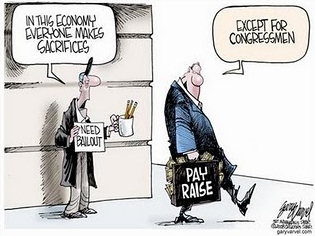The Twenty-Seventh Amendment was proposed as part of the original Bill of Rights, but it failed to be ratified. It was reintroduced in the early 1980s and was ratified in 1992. The Twenty-Seventh Amendment prohibited members of Congress from raising their salaries during their terms of service. Members of Congress cannot receive an increase in salary until after the next election.
This cartoon suggests that Congressmen are greedy, and therefore are prone give themselves pay raises at the expense of the rest of the citizens. The cartoon reemphasizes the need for the 27th Amendment. http://tobuds.com/blogs/blog1.php/2009/12/24/congress-votes-themselves-pay-raise-in-2
The 27th Amendment restricts the ability for Congressmen to receive pay raises. In this video Florida Representative Vern Buchanan pushes for a bill that will prohibit Congressmen from receiving a pay increase until they balance the budget. This would place even more restrictions on the ability for Congressmen to receive pay raises.





